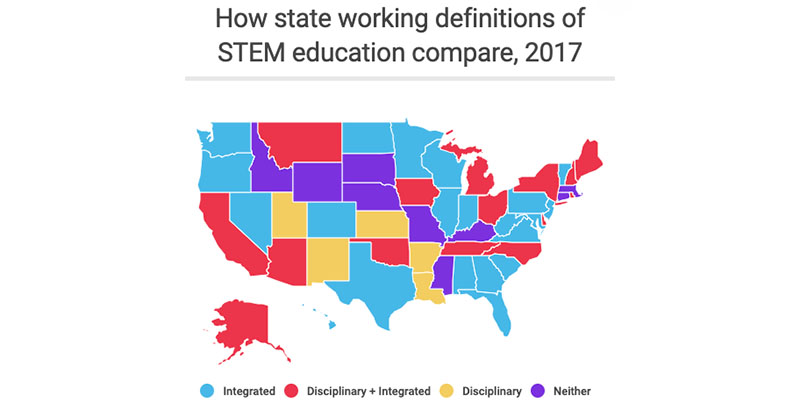The Great STEM Debate: States Can’t Agree on What Those Four Letters Mean, and That’s a Problem

Anyone paying half-attention to schools knows about the acronym STEM: Science, Technology, Engineering and Math, the four pillars supporting a career-ready future for students. There’s hardly another term in the education world that’s as commonly referenced. But when strung together, just what do those four letters — or five if you’re observing National STEM/STEAM Day tomorrow — actually mean?
As it turns out, it depends on who you ask.
The Next Generation Science Standards, developed by a partnership of U.S. states and national research organizations, presents one idea. Emphasizing science and engineering in practice, with a focus on the core disciplines and their intersections, the standards have been adopted by 20 states and the District of Columbia. Another 25 states have versions of those standards with some variations. Five states have entirely different approaches. Unlike with Race to the Top and the Common Core, there are currently no financial incentives for states to sign on to the science standards.
But that’s not all. The National Science and Technology Council released its own plan on the future of STEM education last year. States also have separate individual working definitions of STEM commonly approved through their legislatures. There’s no guarantee that these different conceptions of STEM actually line up with one another. Even within a state, the adopted definition could have little to do with how districts instruct STEM in classrooms.
“No one’s really getting the room together and saying, ‘Let’s nail this [down] so that we have a common language,” said Courtney Carmichael, supervisor of curriculum and instruction for Closter Public Schools in New Jersey.
Carmichael presented her research in June in Philadelphia at the 2019 International Society for Technology in Education national conference, the largest education conference in the country. At the presentation, Carmichael argued that differences in how states understand STEM education have significant consequences for career and college readiness across the U.S.
Scientists in the early 2000s originally coined the term SMET but changed it to STEM for easier pronunciation. It was designed to give students skills to prepare for jobs in growing markets such as engineering and computer programming. But taking highly skilled STEM work and simplifying it for kids isn’t easy. Part of the confusion around STEM comes from what’s lost in that translation, said Nancy Butler Songer, professor of education at Drexel University in Philadelphia. If the end goal is to have an adult build an app or design a bridge, where do you start with a child?
“There are some similarities and some profound differences between what professionals do and what kids should be doing in schools,” she said.
The first disagreement around STEM might be the simplest: What exactly is the relationship between its letters? Educators have been conflicted for years over whether to treat STEM as an acronym — composed of discrete parts — or as an integrated model of teaching.
“I think there’s a fundamental confusion about whether STEM refers to the science and engineering and mathematics disciplines themselves … or whether STEM refers to a different approach to learning that involves collaboration, computational thinking, creativity, problem-solving, design thinking, etc,” Songer said.
Carmichael described one example of the more integrated method as teaching kindergartners how to build a toy boat that will travel from one side of a small pool to the other. It may not be the same as presenting isolated lessons on addition tables and basic physics, but it covers all the bases.
“You have to engineer a boat, you have to make a boat, you have to figure out what floats, you have to understand the principle of why it floats, maybe some ideas about wind, and then you have to incorporate the mast that goes across,” she said. Doing that means weaving together lessons from many STEM fields.
And even for those who accept this interdisciplinary approach, there are different schools of thought on whether “interdisciplinary” is even the right descriptor. The word implies a meeting of distinct subjects, but it doesn’t encompass comprehensive integration, some say. For that, “transdisciplinary” has become increasingly popular.
“Some places say it has to be transdisciplinary to be STEM,” said Songer. “There’s confusion about the definition of transdisciplinary versus interdisciplinary, which just means more than one in my understanding,” she said.
But states can’t seem to agree on whether the integrated methodology is important enough to code into policy. According to Carmichael’s research from 2017, 21 states included some multidisciplinary element in their definitions. Five states defined STEM as siloed subjects and another 15 states included both versions of STEM in their definitions. Nine states used neither.
Massachusetts, typically seen as a leader in education trends, notably opted out entirely from making a STEM definition. The state government has argued that “STEM is currently an acronym without much depth.”
Those variations might seem odd. But it gets more opaque. Because even though states have these working definitions of STEM, there’s no guarantee they are reflected in state policy — or in classroom instruction. Many states have STEM frameworks that extend beyond, and sometimes even conflict with, their working definitions.
“I could put a definition on a Department of Ed website. Box checked, walk away. But when a legislature is appropriating millions of dollars year in, year out,” that definition isn’t the sole influencer on policy decisions, said Jennifer Dounay Zinth, lead consultant at Zinth Consulting LLC and former researcher with the Education Commission of the States.
For example, even though Massachusetts decided not to establish a working definition of STEM, it still has a detailed state plan for excellence in STEM education.
The debate also continues over whether STEM is inclusive enough with its letters. For many educators, STEAM, which includes an “A” for art, is more appropriate. North Dakota, South Carolina and Rhode Island have incorporated STEAM into their working state definitions, according to Carmichael’s research. She argued that art is already covered with the “E” because engineering includes a focus on aesthetics and design.
Other advocates have pushed for even more additions, like STREAM, which includes a “R” for reading — or sometimes religion in religious education — or STEM-H, which includes health.
Carmichael, however, reasoned that with too many additions, the term loses its meaning. Throw art, reading and history into the mix, and what you’re describing becomes well, just school.
These divergent ideas of what STEM means might seem like simple semantics. But semantics are rarely simple. And without a clear working understanding of STEM, the U.S. risks unnecessary barriers to preparing students for the future, Songer argued.
“It kind of doesn’t matter a lot exactly which definition you latch onto, but this is a really important concept for countries and schools and lots of different federal ministries and governments to get right because this is where a growing number of jobs are in the future,” said Songer.
Nationally, there are some ongoing efforts to build more of a consensus, including the STEMx network, which connects education organizations from 16 states across the country, including Tennessee, Ohio and Oregon, to share instructional tools and boost the number of STEM teachers. The network helps its members adapt successful STEM initiatives from one state to another — and understands that state context differs.
“We’re really not focusing on getting a universal agreement on what STEM has to look like. There are components within STEM such as rural education … that apply across the country. So whether we agree exactly on what the definition of STEM has to be, we understand that it is a mindset and a way of thinking,” said Wes Hall, director of STEMx.
Citizen Science, a federal agency, is another example of a push to build interest in STEM by bringing students across the country together with working scientists to contribute to meaningful research.
These are promising steps to researchers including Songer and Carmichael. But more work is needed to keep pace with the demands of the economy — and of the globe. After all, some of the biggest challenges the world faces will require STEM-related solutions, Songer said. Take climate change, for instance. Understanding that global dynamic demands training in chemistry, biology, earth and atmospheric sciences, medicine and more.
“If we’re not attempting to solve those problems by clarifying our stance, we’re never going to get to the point that we’re going to be successful with policy,” she said. “I think we really need to get our act together.”
Get stories like these delivered straight to your inbox. Sign up for The 74 Newsletter

;)
